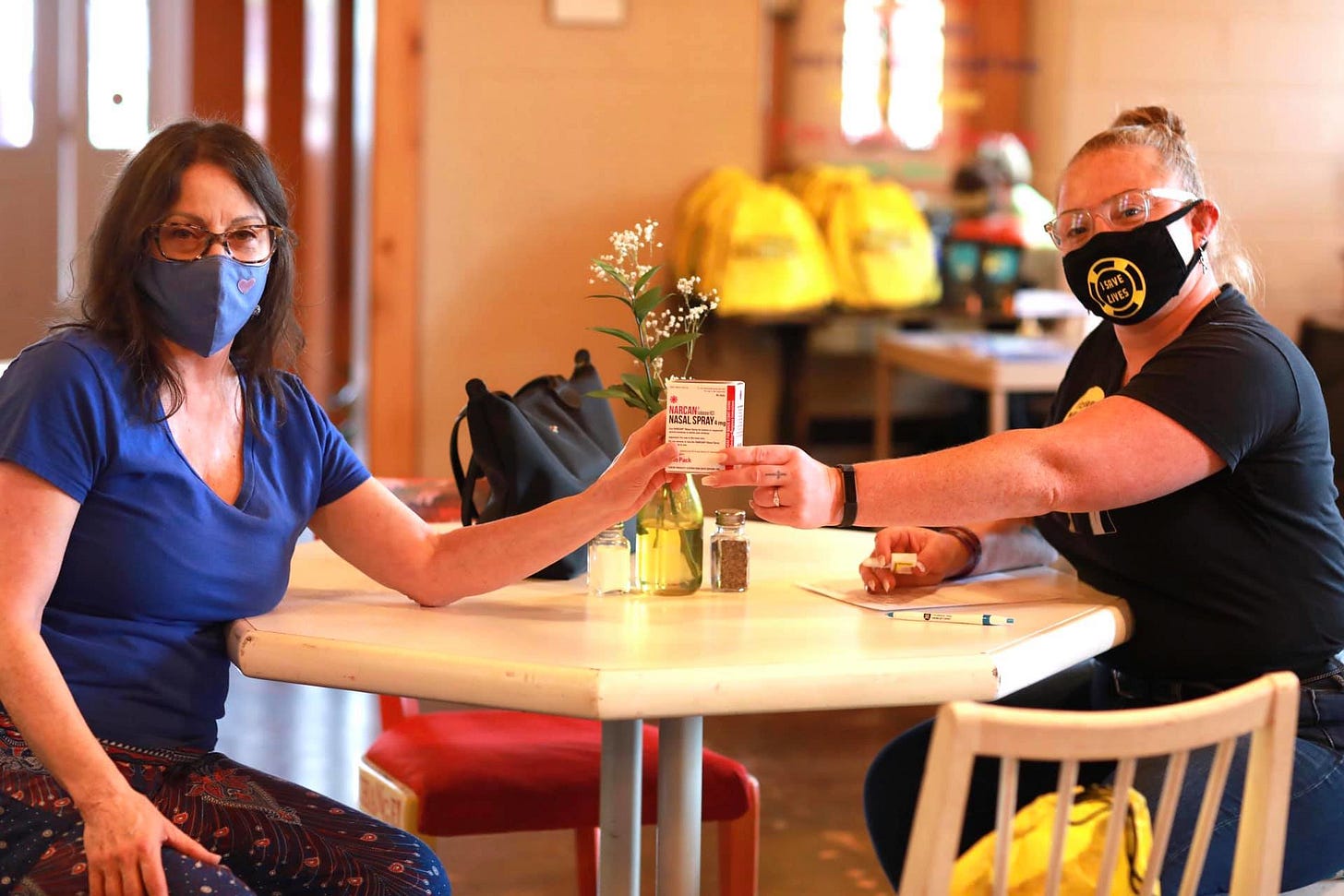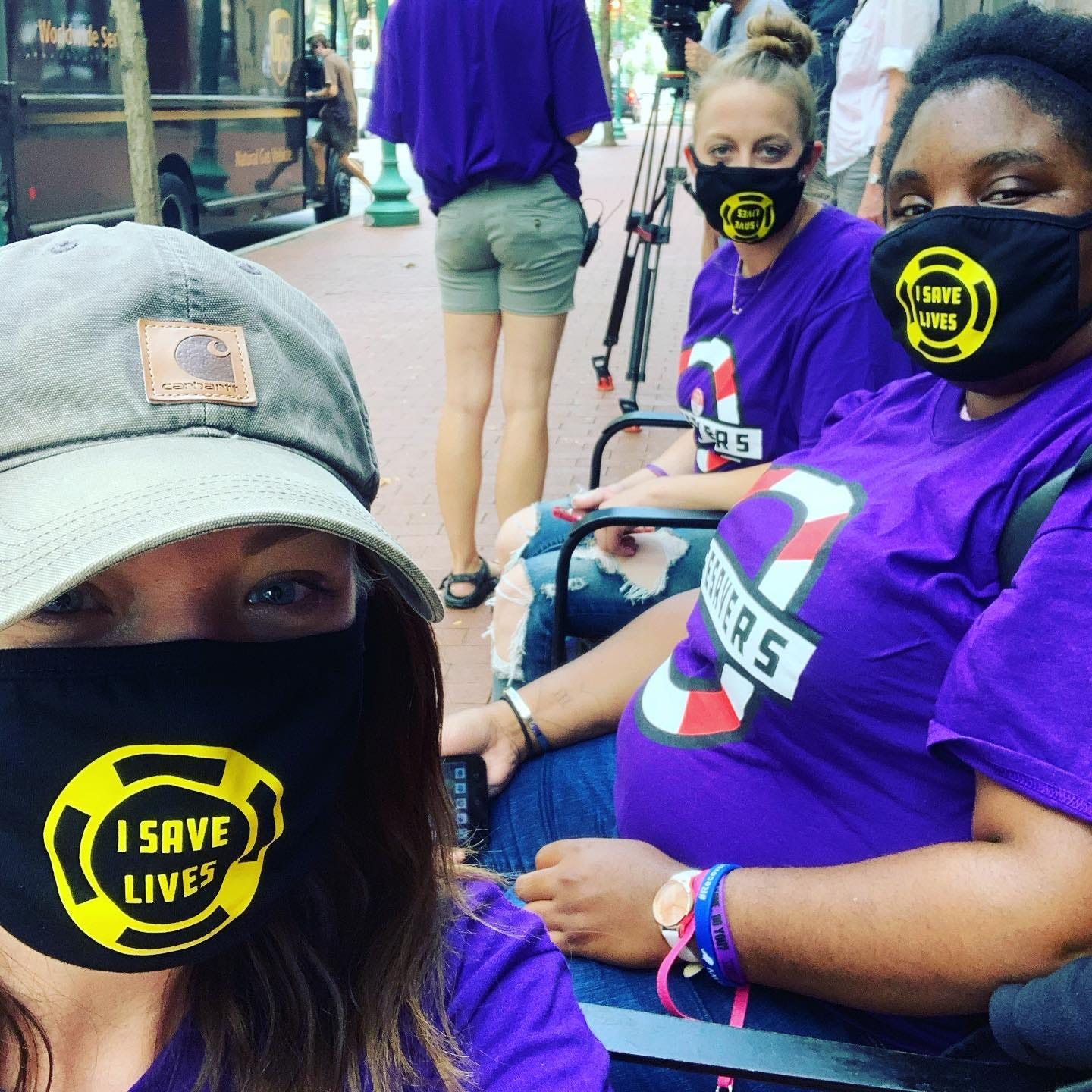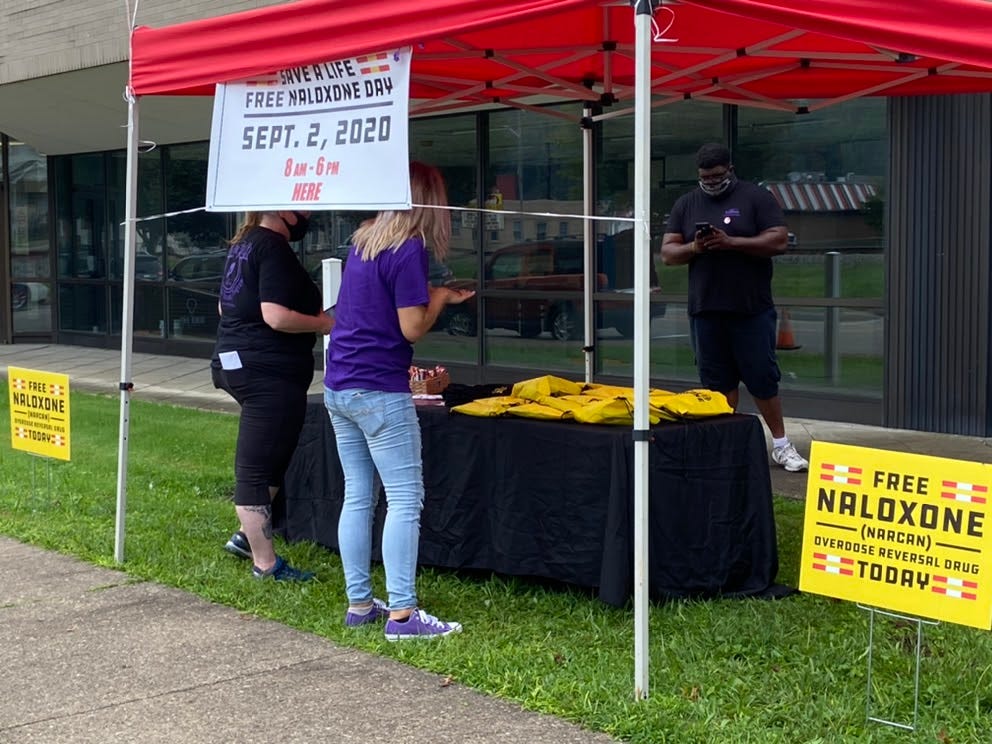Love Letter for WV: 1,000+ Naloxone Kits Distributed in 1 Day
By Joe Solomon, Cabin Creek Health Systems (Coordinator of Addiction Response Kanawha-ARK)

Naloxone training @ “The Depot” in Scott Depot, WV. Photo by Evan Young, Putnam Wellness Coalition.
It’s easy to get overwhelmed when you hear about the overdose crisis.
The news repeats itself, and the heartache returns, year after year after year. Here is Kanawha County, we’ve lost a loved one every three days for the past five years to a drug overdose. Every three days, on average, for the past five years. And that was before the pandemic hit, which has ratcheted up overdoses throughout the state and the country.
And yet: there is much that can be done. Not least because there is an antidote for most of the overdoses that plague West Virginia: Naloxone. 75% of the overdose losses in West Virginia involved an opioid in 2019.
Naloxone was approved by the FDA to reverse opioid overdoses in 1971 - 49 years ago.
So the question becomes: how can we make this medicine widely available and accessible so that whenever and whenever there is an overdose, there is an antidote nearby. In essence, how can we turn entire communities into Lifesavers?

Naloxone training at Cafe Appalachia in South Charleston, WV. Photo by Gayle Woody.
And so in the Spring of 2020, community organizers and healthcare professionals from Kanawha and Putnam Counties jumped on a Zoom call to brainstorm. The WV Office of Drug Control Policy invited us to imagine a regional day of action. One day, where anyone could get free naloxone.
We asked: What if you could pick up naloxone at your local church, or healthcare clinic, or downtown restaurant? What if the Naloxone was free, along with training, and you could get answers about recovery for a loved or for yourself? We put on a date on the calendar: Sep 2nd 2020.

Sissonville Health Center team on ‘Save a Life: Free Naloxone Day’. Photo by Ashley Murphy.
We got busy making calls: calling Pastors and Reverends, healthcare centers, & small business owners. With minimal cold calling, we called up community leaders we already knew. And most places were willing to offer space--there was a hunger to help.
Sure, some places rejected us but most of the rejections weren’t born of stigma but rather valid fears around COVID-19. For the places who said “Yes”, we supplied scores of disposable masks, cheered on outdoor training tents, and emphasized social distancing.
We also wanted to take naloxone out of the medical zone, where everything is sterile and you have to be a professional to use the medicine. That’s not true with naloxone. With a brief training, anyone can administer this medicine. And with a physician’s go-ahead, lay people can even dispense it.
We wanted to flip the question from “Why carry Naloxone?” to “Why wouldn’t you?”

Photo by 84 Agency.
So we asked our friends at 84 Agency and Base Camp Printing if they would create swag we could give out with the Naloxone. And they dreamed up all kinds of wearable festoon-ery….Stickers. T-shirts. Silicone bracelets. Pins. Drawstring bags. Yard signs. Even masks. 84 Agency utilized a beautiful logo and design framework Base Camp Printing developed, and brought all these pieces to dynamite life. Many of the designs were crafted as templates in Canva where they could be customized to support local sites.

Naloxone mobile team getting ready to head out in downtown Charleston, based out of WV Drug Intervention Institute’s new offices. Photo by Keena Mullins.
We also needed a whole slew of volunteers--about 200 to helm what became 17 Free Naloxone Pick-up Sites. So we asked nearby hospitals, colleges & universities, recovery centers, churches, and so on if they could supply folks for 3-4 hour shifts. We set up a basic google form, and word spread quick. We recruited 170 volunteers that way. Nearly every site was powered by volunteer recovery coaches, social workers, newly knighted naloxone trainers, faith leaders and congregants, pharmacy students, and neighbors who knew the town well. Most sites also sent out a field team to train local businesses and soup up their first aid kits. In places like Montgomery and Nitro, folks re-purposed the lawn signs to wave down traffic.

Samantha Jo Facemire & Rusty Williams waving down traffic outside Kingdom Life Fellowship in Nitro, WV. Photo by Gayle Woody.
In the lead up, we held two massive naloxone training for trainers on Zoom with Dr. Lindsay Acree with the University of Charleston Pharmacy School, training over 144 new naloxone educators across Kanawha, Putnam, and beyond.

We made about 40 virtual posters for social media too, shining the light on community members who believe in the power of second chances. The Mayor of Charleston Amy Goodwin, Heroin(e) director Elaine Sheldon, and ACLU-WV’s Joseph Cohen all took part in the poster series. So did a courageous wave of people who had been saved by naloxone.

Naloxone training at Elkview Baptist Church--featuring Dixie the K9 rescue dog. Photo by Tina Ramirez, Director of Marshall Health’s Great Rivers Regional System for Addiction Care.
On Sep 2nd itself, magic happened. Everything came together, with a few hiccups, but mostly a cascade of glorious moments. At the Elkview Baptist Church, the local K9 rescue team picked up a naloxone kit. In Cross Lanes, a mother and father who had lost their 20 year old daughter last year gave out kit after kit to the community. In Hurricane, Church of Christ leader Ed Covert sat with parents whose children were wrestling with addiction and offered counsel and a compassionate ear. In Charleston, mobile teams went under bridges and into tent communities. In Montgomery, the newest cafe now carries naloxone, thanks to the enthusiasm of BridgeValley students. At site after site, mothers and fathers and even grandparents picked up kits to keep their children and grandchildren alive. Conversations about recovery happened everywhere.
Cross Lanes volunteer Nimrah Durrani, a pharmacy student at the University of Charleston, noted that she “expected a lot more recovering individuals to come forward but it was more so community members who have seen overdoses take place around them who wanted to start to carry naloxone.”

Danielle Dials & Marcella Romeo after a naloxone training in Palms Salon in Cross Lanes, WV.
By the end of the day, most sites ran to zero kits. Some sites barely caught their breath between trainings, while a few sites based in smaller towns still moved scores of kits, and sent some of their surplus to help the more breathless places.
All told, it was a smashing success. Our amazing volunteers trained over 1,000 people, equipping each of them with their own naloxone kit.
1,000 kits also represents 1,000 conversations - busting through stigma, offering solace to those who’ve lost someone, and helping connect people with recovery resources and ultimately hope. Many tears were shed.

Free Naloxone Day volunteers @ the Serenity Club in Dunbar, WV. Photo by Rachel Thaxton.
We were able to do this in large part thanks to the generosity of the Greater Kanawha Valley Foundation, the CAMC Foundation, and the Kanawha-Charleston Health Dept. Even a half century later, and naloxone is still about $75 a box wholesale for the brand name nasal spray, Narcan.
Yet there are other ways to get free or cheap naloxone, from your Health Department, Next Distro, the Southern WV Collegiate Recovery Network, Direct Relief, and a Buyer’s Club. And now that the swag is already designed--that reduces some of the legwork too.


BridgeValley naloxone training tent and three freshly trained participants in Montgomery, WV. Photos by Carla Blankenbuehler.
If you are keen to work on a Free Naloxone Day in your town, county, or region, it is possible. And we can help. You can see all of our organizing resources here in this online folder. And if getting naloxone is the hurdle, we can overcome it together. Please get in touch.
The overdose crisis is overwhelming. For many of us, it is loss upon loss. It is a list we keep close, of loved ones, friends, and co-workers, who we honor through their memory and love. Naloxone Days are in many ways a love letter to the people we still have with us. A letter that may arrive just in time.


